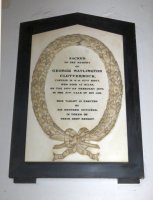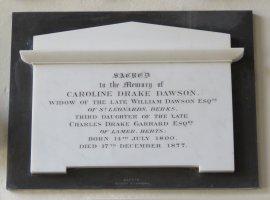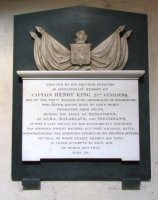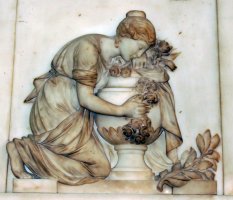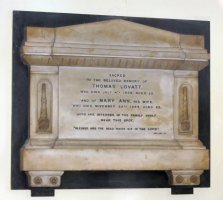Edward & Thomas Gaffin (Gaffin of Regent Street)
White-on-black panels by Gaffin of Regent Street.
The most common memorials in English churches are the white on black panels, fairly simple and with minimal or modest sculptural decoration, dating from the late 18th and early 19th Centuries. Of these, the firm of Gaffin of 63 Regent Street, London almost certainly produced the most. The family firm was active from the 1800s under first Edward Gaffin, who was then joined by his son Thomas Gaffin, and continued in production through to at least 1906.
Girl with pot, by Edward Gaffin.
The large majority of the work is of the simple white panel on black backing type, in the ‘tomb chest end’ or ‘casket tomb end’ varieties, which is to say the white panel is cut as if we were looking end-on, or side on, to a three dimensional monument, with upper and lower shelf, a lid above, and little feet below. There are many of these in the Gaffin oeuvre, sometimes with no carving at all, just pieces of marble cut to shape, and often with some very minor carving such as an emblem on the pediment-like lid. The historian of English tomb sculpture, Rupert Gunnis, was disparaging about the Gaffins on the grounds of their large production of such plain and unambitious white-on-black panels, but I think half a century on we can be kinder, if only because so much has been lost, and so much more recent monumental work is of indescribably lower standard.
Typical panel by Gaffin of Regent Street, with upturned torches.
And the firm did make some more ambitious things. The Gaffins made a number of similar tomb chest ends and casket ends with a high relief pot or funeral urn carved on top, typically a broad pot with a narrow stem, or a rounded one with a symmetrically drooping plant in it. For military figures, the pot would be replaced with crossed flags, giving opportunity for minor drapery, and perhaps the regimental shield of arms in front of or above this.
There are also examples, not so many, where a figure in high relief is included – we cannot generally be sure if such figures were carved by one of the Gaffins, or some sculptor they employed specifically for the purpose. An example is the seated female figure in Exeter Cathedral on the Sophia Charlotte Hennis monument, and a much more accomplished one in Leyton Parish Church in London – the latter is conventional in pose – a girl mourning over an urn – but fine in execution and the treatment of the drapery. The standing girl on the Sarah Willim monument, again a rather finely draped example, is signed specifically by E. Gaffin (i.e. Edward Gaffin), and the monument to Edmund B. Beynham with a little figure of Justice in Carshalton Parish Church, for example, is signed T. Gaffin (Thomas Gaffin). However, while some work of the firm is signed by E. Gaffin or T. Gaffin, more usually it is just Gaffin, so again we cannot say who specifically carved the monument.
Given the large volume of the firm’s production, it is not surprising that now and again they produced some monument far from their usual types; an example would be the monument to Sir Joseph Bazalgette in Wimbledon Parish Church, which has well carved wild roses climbing around a frame of wooden sticks surrounding the central inscription, an unusual and successful composition.
Introduction to Church Monuments // White-on-black monuments
